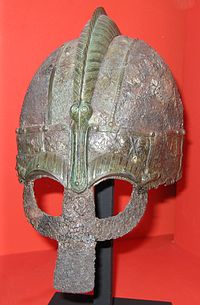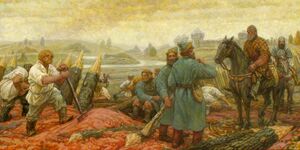Gorkokhunyonbokok
Görkökhunyónbokök | |
|---|---|
 Iron Horde helmet (3923 BW) | |
| Total population | |
| 65,000+ | |
| Regions with significant populations | |
| Historic Margno Historic Görkírsk | |
| Languages | |
| Görkök | |
| Related ethnic groups | |
| Görök, Görkírsz, Vezéknit, Főlyík, Főlyanós, Görszák |
The Iron Hordes (Görök: Görkökhunyónbokök), (Görkök: TBA) were a nomadic Görök people that inhabited the northern coastline of TBA in present-day Margno. The Görkökhunyónbokök were never fully assimilated by the Romantic kingdoms of the region during their presence in Margno, allowing for the temporary settlement throughout the region and the construction of over seventy marked and mapped raiding camps, strategically placed to provide the highest efficiency when conducting military operations. While never fully assimilated, the Görkökhunyónbokök were still thoroughly persecuted by their Romantic overlords, forcing many to adopt their own systems and government institutions independent of the Romantic kingdoms and vassals of the time. At their peak, the Görkökhunyónbokök supported a population of over 65,000. However, after the year 3800 BW this population would experience a steady decline due to fierce resistance from Romantic locals and authorities. In 3,700, the Görkökhunyónbokök were repulsed after a bloody battle between the migrating Romantic peoples and the Görkökhunyónbokök in the Görkökhunyónbokök capital of the time, Görökvárnak. Their loss at Görökvárnak resulted in their expulsion from the south side of the Ápül bay, forcing them to attempt a dangerous water crossing which would result in the annihilation of up to 20,000, including those slain or executed by Romantic warriors.
Etymology
The origins of the name “Görkökhunyónbok” and the demonym “Görkökhunyónbokök” are highly disputed, however it is most likely that the name is a modern application for an ancient and now extinct people, as there is no known name that the Görkökhunyónbokök had attributed to themselves in all retained records regarding their existence and recording of their own history. Görkökhunyónbokök is the Görkök translation of “Iron Hordes”, a name in which the small collection of Görkök communities situated in the north of modern-day Margno is commonly referred to. The origins of the name are unknown, however it is likely that the name was given to the group because of their traditional iron helmets, which they were known to wear into battle.
History
Origins
It is unknown as to where the Görkökhunyónbokök originated. It is believed that the language was created as a result of multiple isolated mountain communities constructing their own languages and cultures independent from the surrounding Romantic kingdoms that shared the region with them. Migrating from deeper into the continent, the Görkökhunyónbokök would inevitably find themselves along the western coast of the continent in present-day Margno. Unsure as to how to progress, the Görkökhunyónbokök would choose instead to settle down, living off the land peacefully and undisturbed. At least until the Romantic kingdoms continued their migration northwards, free to engage the now vulnerable communities of Görkökhunyónbokök that had made the land into their home. Cultural and religious differences mixed with an ever-growing demand for natural resources, the Romantics would begin to engage the Görkökhunyónbokök in a number of skirmishes. Unfamiliar with warfare, and unprepared for engagements of such nature, the Görkökhunyónbokök would inevitably be beaten back and driven across the Ápül bay, costing them half of their population in the process. Here they would oversee the establishment of various new independent kingdoms politically separate from each-other, marking a new era for the Görkökhunyónbokök and paving the way into the modern day.
Creation of Gorokvarnak
As technology progressed, so did the demand for resources. Once the Görkökhunyónbokök had completed their long migration, they were left vulnerable and without an ample food supply. Agricultural revelations of the time had been picked up on by members of the Görkökhunyónbokök and brought with them to their place of settlement. This allowed for many to begin farming extensively alongside the already existing hunting culture practiced by the Görkökhunyónbokök. The need to settle down and provide for themselves resulted in the creation of a large city, a population of around 10,000, that would be strategically positioned to benefit the Görkökhunyónbokök not just defensively but also economically. The city would gradually grow in size over the course of a century, before being inevitably destroyed by the advancing Romantics.
The Mountain Wars
The Mountain Wars were a series of barely documented conflicts between the Görkökhunyónbokök and the prehistoric Romantic kingdoms migrating into present-day Margno. The conflicts would result in the annihilation of up to 30% of the Görkökhunyónbokök population, as well as their removal from the region in which they had settled in. The wars would culminate in the Battle of Görökvárnak, after which the Görkökhunyónbokök would be driven out of their settled lands, across the Ápül bay. Although short, the minor losses that the Görkökhunyónbokök sustained would result in the loss of over half of their population and much of their development. They would be forced to start from scratch in the wilderness of the north, where even more of their population would perish while braving the elements.
Extinction
The extinction of the Görkökhunyónbokök identity would come shortly after the Görkökhunyónbok arrival in Görkírsk; Immediately upon arrival, many Görkökhunyónbok settlers had established isolated communities independent of each-other, for the large loss of life sustained during the Görkökhunyónbokök pilgrimage to Görkírsk had cut the Görkökhunyónbokök population down considerably, preventing the creation of any initial large population centers. For centuries, the Görkökhunyónbokök populations that settled the wilderness remained dispersed and unwilling to centralize. This in turn caused the diversification of the Görkökhunyónbokök, splitting the greater Görkökhunyónbokök culture into four separate cultures with unique traditions and ways of life, influenced by the ideas that they had brought with them from their migration.
Culture
Language
The Görkökhunyónbokök predominantly spoke Görkök, an old Görök language influenced by grammatical concepts constructed during isolation and their migration across the continent. The Görkökhunyónbokök first used a unique Runic alphabet upon their arrival at the bay, and gradually developed their language to be both speakable and writable. The language was brought to Görkírsk with the Görkökhunyónbokök after their removal from Margno, until the language was gradually replaced by a number of successor dialects that had developed after the extinction of the Görkökhunyónbokök culture.
Religion
The Görkökhunyónbokök followed various Pagan and Animist faiths unique to their own peoples that had been developed during their migration northwards.
Architecture
The Görkökhunyónbokök settlements maintained a very primitive style of architecture; to avoid the expenses of a well-fortified position, the Görkökhunyónbokök instead chose to construct settlements surrounded by wooden walls made of debarked tree-trunks covered in a paste mixture comprised of tree sap and sam intended to prevent the spread of fire. Within the settlement, houses were typically big enough to house families of two or three and were only one story with straw roofs. Larger Görkökhunyónbok settlements would sometimes have moats and cobblestone roads or house bases, the largest Görkökhunyónbok settlements would sometimes have stone walls that stood five or six feet high, although these were extraordinarily rare.
Physical Appearance
In the majority of documentation regarding the Görkökhunyónbokök, the Görkökhunyónbokök are described as shorter men of larger frames, with typically black or brown hair and black or brown eyes. Görkökhunyónbokök were known for having longer faces and very tan skin.
Economy
Currency
The Görkökhunyónbokök did not possess any form of paper or coin currency, instead relying on material items as a form of trade. The Görkökhunyónbokök were also known to provide labor or even children as forms of compensation whenever necessary.
Politics
Government
The typical Görkökhunyónbokök settlement was ungoverned and relied almost entirely on tradition to maintain order. Many settlements would elect settlement leaders, which would in turn collect tax and use the items seized to pay for a settlement's protection and development. The system was ahead of its time for the communities, however tax at the time was collected in the form of material items due to a lack of any standardized Görkökhunyónbokök currency. This left many communities poor and without wealth.
Law
The Görkökhunyónbokök possessed a number of complex rules and laws under which they governed themselves. The Görkökhunyónbokök were known for their ability to maintain identical societies despite their decentralized way of living. They were able to do this because of a Görkökhunyónbokök code that enforced specific similarities between different Görkökhunyónbok settlements and societies. For example, every Görkökhunyónbokök society likely operated under a curfew, which forbade a settlement's population from wandering about past a certain hour. This is because the Görkökhunyónbokök didn’t trust the local Romantics, and instead opted to remain in their own spheres rather than assimilate with the Romantics, whom they possessed a long-time rivalry with. Additionally, the Görkökhunyónbokök operated under the belief that raids should only be conducted in the later hours of the day, preferably night. This is because the Görkökhunyónbokök would spend the early hours of the day hunting for whatever game they could get their hands on, and any excess time would go towards contributing towards their settlement. This way the Görkökhunyónbokök could conduct a daily patrol or raid at night, transforming it into a daily tradition. Men in Görkökhunyónbok society typically assumed responsibility for all political and combat roles, and any role that required intensive labor. However, women were still treated as equal and were not expected to fulfill domestic roles. Homosexuality was also never criminalized.
Legacy
Influence
Today, the Görkökhunyónbokök possess very little influence in the present-day. The remnants of the Görkökhunyónbokök peoples in Görkírsk have been reduced to archeological sites uncovered in various locations across the country. The ancestors of the Görkökhunyónbokök peoples remain today throughout Görkírsk, and other small communities scattered around Görkírsk. However, their culture, alphabet, and language has all but vanished. Today, they remain only in history and through descendents that continue their legacy in the form of the Görkök.
Warfare
The Görkökhunyónbokök were notorious for utilizing hit-and-run tactics to effectively cripple opposing armies. The Görkökhunyónbokök rarely engaged in organized combat, and had a unique array of weapons that would continue to be used by their descendants.

